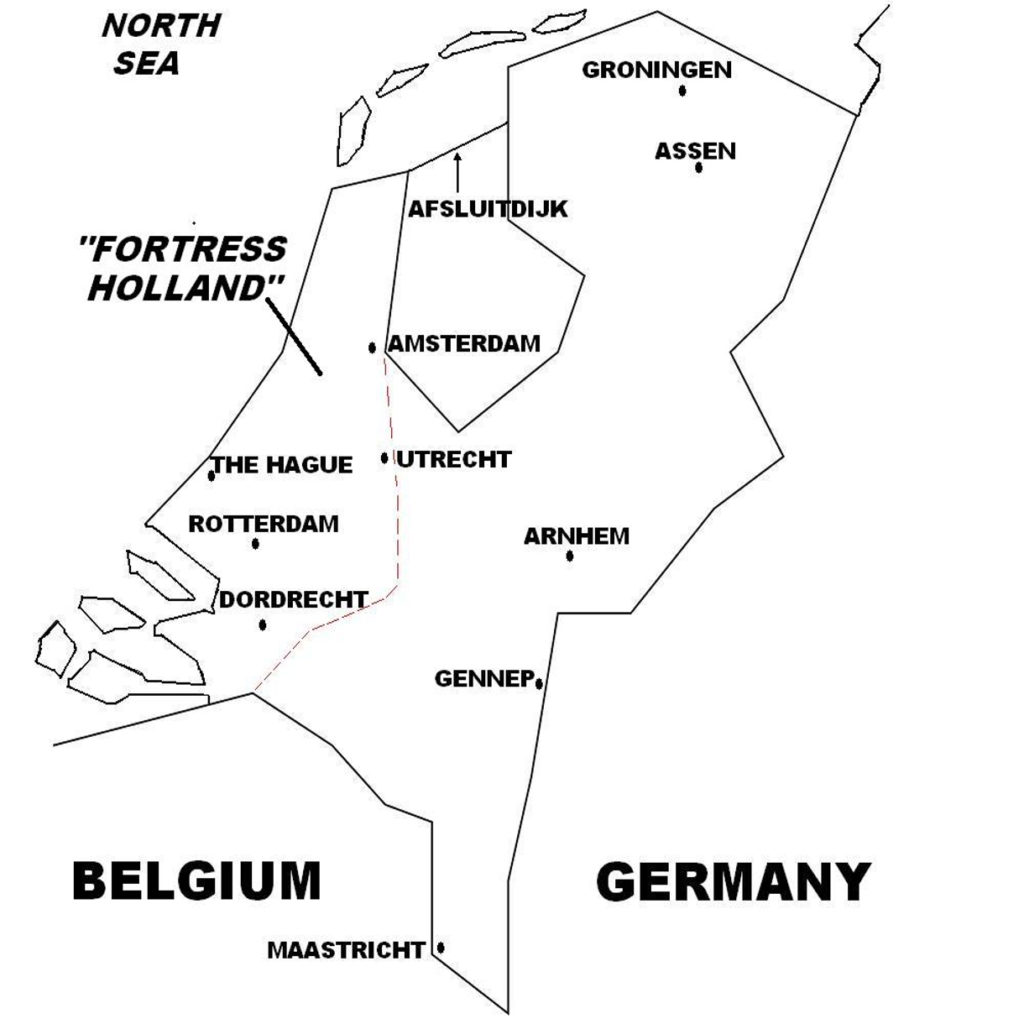On May 13, 1940, with Dutch military resistance faltering from the German onslaught, Queen Wilhelmina and her court, together with the Dutch government, were evacuated by a British Royal Navy ship to Britain, where they established a Dutch government-in-exile that functioned for the rest of the war.
At various times in the development of Fall Gelb (the planned German invasion of Western Europe), the Netherlands or only part of it was considered, since the Germans planned that their main thrust would be through Belgium on the way to their final objective, France. However, the Germans (as did the Allies) saw the western part of the Netherlands as the northern end of a battle line if war would break out, and which therefore had to be defended against a potential flanking maneuver by the enemy. For Germany, especially Luftwaffe head Hermann Goering, the air bases in the Netherlands could be used to launch bombing raids on Britain, much the same way that the British, if they captured the Netherlands, could use these bases to attack Germany.
In World War I, the Dutch policy of neutrality had been respected by the belligerents, and the Netherlands was not invaded. As a result, with increasing tensions in Europe during the 1930s and even after war broke out in September 1939, the Dutch continued to hope that their country would be spared the horror and destruction that their neighboring countries had suffered in the Great War.

The Netherlands was not militarily prepared for war, and only began to upgrade its World War I-era war capability in 1936, belatedly after nearby countries Germany, France, and even Belgium were already spending large amounts of money on their respective armed forces. With war looming by the late 1930s, the Netherlands had great difficulty purchasing weapons, as deliveries from Germany were deliberately stalled by the Nazi government, and the Allies, particularly France, refused to sell weapons without the Netherlands first joining the Allies.
Hitler was fully aware of Dutch unpreparedness for war, and predicted that the Netherlands would fall in 3-5 days. Thus, for the attack on the Netherlands, the Germans assembled its weakest force, the 18th Army, among all the forces involved in Fall Gelb. An important component were the airborne assault units (paratroopers and airborne infantry) which were assigned to seize key sites inside Fortress Holland, and capture Dutch Queen Wilhelmina and the Dutch government at The Hague in order to force Dutch surrender within one day.
On May 10, 1940, Germany invaded the Netherlands, which formed part of Fall Gelb, the simultaneous coordinated German offensives into France and the two other Low Countries, Belgium and Luxembourg. The Germans crossed the border into the Netherlands along two points: German 18th Army at Gennep and German 6th Army at Maastricht. German 6th Army, which was the more powerful, was not assigned to the conquest of the Netherlands, but instead proceeded from Maastricht across the border into Belgium, its real target.
The airborne operations, which highlighted the German aim to quickly force Dutch surrender, was launched also on May 10, with paratrooper and glider infantry units penetrating Fortress Holland by seizing the bridges at Moerdijk, Dordrecht, and Rotterdam, and the Waalhaven airfield near Rotterdam and the three airfields (Ypenburg, Ockenburg and Valkenburg) near The Hague. The Dutch offered stiff resistance at The Hague that broke off the German attack. Dutch forces then recaptured the three airfields and inflicted heavy losses on the Germans, including over 2,500 killed, wounded, or captured, and 175 air transports destroyed or damaged.
On May 14, the commander of German forces at the Rotterdam front demanded that the Dutch defenders in the city lay down their weapons and surrender themselves and the city, or face an all-out German infantry, armored, and air assault. Negotiations followed, and as a second German ultimatum was being delivered following the Dutch returning the first ultimatum because of a technicality, German bombers appeared on the sky above Rotterdam.
By this time in Berlin, Hitler chafed by what he saw was the slow progress to bring about Dutch surrender, and as a result, the Luftwaffe sent 90 heavy bombers to bombard the Rotterdam. In the bombing, called the “Rotterdam Blitz”, a large section of the city was destroyed, causing 900 persons killed, 85,000 homeless, and the loss of 25,000 houses, 3,000 buildings, and dozens of churches and schools. Immediately thereafter, the Dutch forces at Rotterdam surrendered, and the Germans entered the city. The Rotterdam bombing had a devastating effect on Dutch morale: when the Wehrmacht threatened the cities of Utrecht and Amsterdam with a similar fate, the Dutch high command gave up the struggle, and on May 15, 1940, the Netherlands surrendered.
Fighting continued until May 19, when the Germans expelled French forces still fighting in Zeeland Province in the extreme southwest. The German 18th Army thereafter joined the invasion of Belgium, providing the northern flank of the German advance there.
